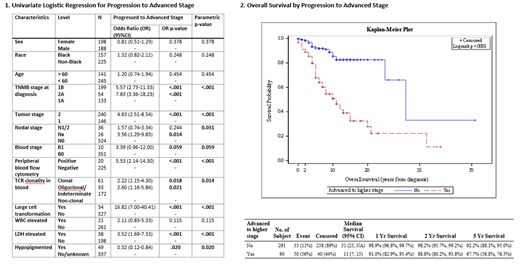Abstract
Introduction:
Advanced stage mycosis fungoides (MF) has a median survival of 3-5 years, while early stage MF is a chronic disease typically associated with an excellent prognosis and a median survival of 20 years or more. Prior studies suggest approximately 20% of early stage MF may progress to advanced stage, but risk factors for progression remain poorly studied, particularly among African American (AA) patients. We aimed to identify clinic features associated with progression to advanced stage MF in a large urban medical center.
Methods
We performed a retrospective review of 388 patients with early stage (1A-2A) MF at the Winship Cancer Institute of Emory University diagnosed between 1970 and 2021. Clinical data collected from the electronic medical record included demographics, laboratory values, disease characteristics, and therapy. Our primary endpoint was to identify variables associated with progression to advanced stage MF. Progression to advanced stage was defined as a highest overall TNMB stage of 2B-4B. Overall survival (OS) was measured from time of diagnosis to date of death or last follow-up. Kaplan-Meier curves for OS were generated for the whole cohort and by progression group. Descriptive analysis was performed for each variable, and a comparison between patients who did or did not progress to advanced stage was performed using ANOVA for numerical covariates and chi-square test for categorical covariates. The association of baseline variables with OS was modeled by Cox proportional hazards model and multivariable analyses were performed on significant variables.
Results
Among 388 patients, the median follow up was 5 years (range 0-51). There was even distribution among male (49.0%) and female (51.0%) patients. The median age at diagnosis was 53 years (range 8-95). This population included 41.4% AA, 55.0% White, 2.3% Asian, and 1.3% other races. Stage distribution was as follows: 34.2% (n=133) stage 1A, 51.5% stage 1B (n=200), and 14.2% stage 2A (n=55). Forty-nine patients had hypopigmented MF (45 AA), and 9.4% (n=34) patients developing large cell transformation (LCT) during their disease course. Treatment at diagnosis was topical in 52.3% (n=203), systemic in 1.8% (n=7), radiation in 3.4% (n=13), and multimodality in 29.4% (n=114).
Overall, 93 patients (24.1%) progressed to advanced stage. Progression to a higher stage was statistically associated with higher overall TNMB stage at diagnosis (p<0.001), T2 tumor stage (p<0.001), nodal involvement (p=0.031), positive blood flow cytometry (<0.001), T-cell receptor (TCR) clonality in the blood (p=0.014), LCT (p<0.001), and elevated lactate dehydrogenase (LDH) (p<0.001). Patients with hypopigmented MF were less likely to progress (hazard ratio 0.32 (95% CI 0.12-0.84) p=0.020), Sex, race, age, blood stage, and white blood cell count were not associated with risk for progression. Univariate logistic regression is summarized in figure 1.
Progression to advanced stage was associated with an increased risk of death (4.75 (0.05-7.38), p < 0.001, figure 2). The median survival for patients who did and did not progress were 11 years (95% CI 7, 15) and 31 years (95% CI 25, not reached), p<0.001 respectively. Other factors associated with an increased risk of death included age > 60 (p <0.001), higher TNMB stage at diagnosis (log rank p<0.001), advanced nodal stage, (p=0.005), positive peripheral blood flow (p=0.010), TCR clonality in the blood (p=0.039), LCT (p< 0.001), elevated LDH (p<0.001), and elevated WBC (p<0.001), while hypopigmented MF was associated with a decreased risk of death (0.28 (0.09-0.90), p=0.021). On multivariable survival analysis controlling for hypopigmented MF, LCT, and stage at diagnosis, only age > 60 (3.32 (2.00-5.51), p<.001) and progression to advanced stage (4.02 (2.38-6.79), p<0.001) remained statistically significant.
Conclusions
We demonstrate that progression to advanced stage is associated with several baseline laboratory and disease characteristics, which bear immediate clinical relevance to the work up and staging of early stage MF. These data suggest that consistent staging and laboratory analyses with imaging for lymph node assessment, peripheral blood flow cytometry, and TCR in all newly diagnosed MF patients may aid in identifying patients at risk for progression to advanced stage disease.
No relevant conflicts of interest to declare.


This feature is available to Subscribers Only
Sign In or Create an Account Close Modal